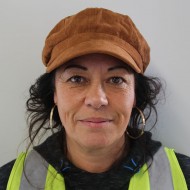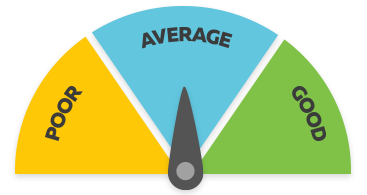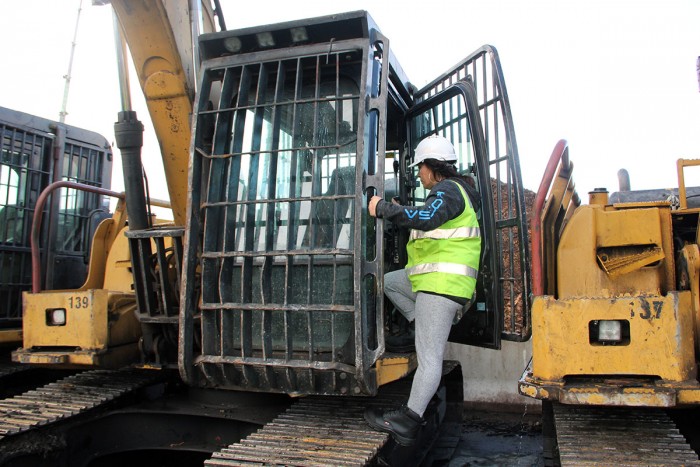Stevedore
Kaimahi Taunga Waka
Alternative titles for this job
Stevedores operate a variety of heavy machinery to load, unload, tally and stow the cargo of a ship.
Pay
New stevedores usually earn
$49K-$80K per year
Stevedores in a supervisory role usually earn
$80K-$130K per year
Source: Port Industry Association, 2018.
Job opportunities
Pay
Pay for stevedores varies depending on skills, experience and the type of work they do.
- New stevedores starting out as cargo operators usually earn between $49,000 and $80,000 a year.
- Experienced stevedores who operate heavy machinery or work in supervisory roles usually earn between $80,000 and $130,000.
Source: Port Industry Association, 2018.
- PAYE.net.nz website - use this calculator to convert pay and salary information
- Employment New Zealand website - information about minimum wage rates
(This information is a guide only. Find out more about the sources of our pay information)
What you will do
Stevedores may do some or all of the following:
- operate heavy vehicles and machinery, such as straddle carriers, forklifts and ships' cranes, to load and unload cargo from trucks, ships and rail transport services
- position and secure cargo in the holds of ships using braces
- carry out safety checks on equipment
- secure and release mooring lines of ships.
Skills and knowledge
Stevedores need to have:
- knowledge of health and safety procedures
- skill operating heavy machinery such as straddle carriers, forklifts and ships' cranes
- knowledge of how to handle different types of cargo, particularly containers of dangerous substances
- knowledge of basic customs and shipping company documents
- the ability to interpret ship loading plans.
Working conditions
Stevedores:
- work flexibly, due to changing ship schedules most stevedores don't know in advance what hours they will work each day
- may work early mornings, weekends and nights
- spend most of their time working outdoors at ports, and in container terminals and the cargo holds of ships
- work in most weather conditions and around heavy machinery
- may have to travel to other ports for work.
What's the job really like?

Linda Kingi
Stevedore
How did you get into stevedoring?
“I was a solo mum getting back into the workforce when I applied for an office job with ISO (a port logistics company). I got the job and from there trained up and progressed.
“I was the first woman to operate cranes for our company. At the time I actually did an interview with the newspapers and they thought I was the first woman crane driver in New Zealand. I’m not sure if that’s factual but once I was signed off it opened up the doors for other women and now there are lots of us.”
What do you enjoy and find most challenging about your work?
“I definitely enjoy operating machines. Operating a machine is good fun.
“I look forward to coming to work. I wouldn’t have stayed here for so long otherwise. I love it, I really love it.
“Learning to have a good relationship with the boys was a challenge when I started – getting the males to accept a female in their area. But things have changed and now about 30% of my co-workers are female.
What advice would you give someone wanting to get into stevedoring?
“If it’s something you think you could enjoy, go for it! It’s best to start from the ground and learn the job from the bottom up. And also be mindful that it’s shift work and you’ll be travelling around a lot.”
Stevedore video
Grease Tevao talks about life as a stevedore – 1.43 mins.
From where I'm from, we usually go out to sea and fish or swim.
That's one of the reasons I like to be here. I like my job.
Hi,
my name is Grease and I am a stevedore.
My main role as a stevedore is to move boxes in here from the ship, to the port,
around the port and out to the public. If you want to become a stevedore,
the first thing you have to do,
you have to learn to become a lasher and this is what the lasher is going to do.
Follow me. The ships come in to port like this.
So your duty is to unlock all these lashing bars. To unlash the bars,
you have to do it in pairs. So I have my friend here to help me out.
That's how you do it. To become a lasher, there's no need for qualifications,
we can train you for 3 weeks. From that, you can become a straddle driver,
which is that kind of machine. This is how high the straddle is,
so you better love heights. To become the straddle operator,
you'll have at least 4-6 weeks of training.
Then you'll be able to drive the machine alone by
yourself. As you can see, we are in a straddle simulator,
where you train to become a straddle operator. The most difficulty
in your job, if you drive long hours without rest,
you might end up fatigued. So make use of the breaks. Two hour drive,
40 minutes break. My favourite part of my job is meeting the people here in the
port because they're very friendly and it's more like a family here.
Entry requirements
To become a qualified stevedore you need to train on the job and gain a New Zealand Certificate in Port Operations – Heavy Machine Operation (Level 3). MITO is the industry training organisation that oversees this certificate.
Stevedores may also be required to hold a Class 2 (heavy vehicle) or higher driver's licence with an F endorsement.
Some employers may require you to pass a medical test.
- MITO - information about the New Zealand Certificate in Port Operations (Heavy Machine Operation)
- New Zealand Transport Agency website - information on heavy vehicle licences
Secondary education
There are no specific secondary education requirements to become a stevedore. However, NCEA Level 2 English and maths are useful.
Additional requirements for specialist roles:
Crane operator
To become a crane operator you need to complete the New Zealand Certificate in Crane Operation (Level 3 and 4) through Te Pūkenga.
Personal requirements
Stevedores need to be:
- adaptable and practical
- safety conscious
- reliable
- able to work well in a team
- able to follow instructions
- good communicators.
Useful experience
Useful experience for stevedores includes:
- work with heavy machinery and vehicles such as forklifts, truck and trailer units, and track and roller vehicles
- work in port or freight industries and at heavy plant facilities.
Physical requirements
Stevedores need to be reasonably fit and healthy. They should have good upper body strength, hearing, eyesight (with or without corrective lenses) and balance. They should also be comfortable working at heights.
Find out more about training
- MITO
- 0800 88 21 21 - info@mito.org.nz - www.mito.org.nz
- Te Pūkenga
- 0800 327 648 - https://earnlearn-tepukenga.ac.nz
What are the chances of getting a job?
Your chances of securing full-time work as a stevedore are best if you work as a part-time casual employee to gain the required skills, and are enthusiastic and reliable.
Most stevedoring work is part time
Most stevedoring work is part time and staff turnover in full-time positions is very low.
There is more part-time work when ports are busier during fishing seasons and when imports arrive from overseas.
Qualifications key to full-time work
Stevedore employers will only take on permanent staff who have the New Zealand Certificate in Port Operations – Heavy Machine Operation (Level 3).
Full-time job opportunities for stevedores have declined due to:
- variable shipping schedules, so more casual labour is used
- automation and the introduction of mechanical loading and unloading equipment.
According to the Census, 2,043 stevedores worked in New Zealand in 2018.
Most stevedores work for private shipping companies
Stevedores mainly work for private stevedoring companies, who contract them out to New Zealand's port companies.
Sources
- Harvey, A, chairperson, Port Industry Association Education and Training Committee, Careers Directorate - Tertiary Education Commission interview, February 2018.
- MITO, 'Port Operations (Heavy Machine Operation) factsheet', accessed February 2018, (www.mito.org.nz).
- MITO, 'Stevedoring and Ports 2017', accessed February 2018, (www.mito.org.nz).
- Rowe, S, recruitment consultant, ISO Limited, Careers Directorate –Tertiary Education Commission interview, February 2018.
- Stats NZ, '2018 Census Data', 2019.
(This information is a guide only. Find out more about the sources of our job opportunities information)
Progression and specialisations
Stevedores may progress by moving into supervisory, management, or planning and logistics roles.
Stevedores may specialise in operating:
- straddle carriers
- cranes
- forklifts.
Last updated 25 March 2025


